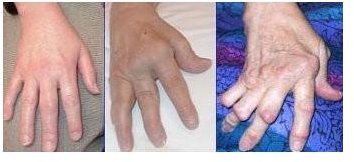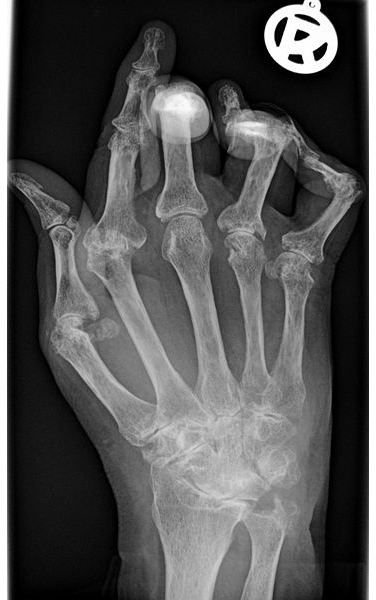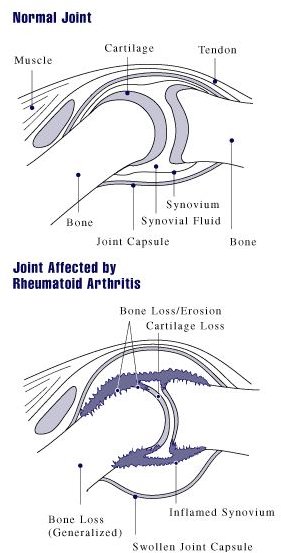About the Cause of Rheumatoid Arthritis: How Abnormal B Cell-T Cell Interaction Can Cause this Autoimmune Disease
Causes of Arthritis
Research strongly suggests that the cause of rheumatoid arthritis are primarily associated with abnormal B cell-T cell interaction. The interaction between HLA-DR cell surface receptor on the T cell and the antigens of B cells produces rheumatoid factors (RF) and anti-citrullinated protein/peptide antibodies (ACPA). This releases tumor necrosis factor (TNF) as well as other cytokines that cause inflammation.
Specifically, the RF and ACPA interact with immunoglobulin Fc receptors to create a situation where equal amounts of antigens and antibodies exist. This is called Type III hypersensitivity and features a number of cross links between the two. Type IV hypersensitivity can also occur when the TNF is stimulated by interleukin-17, causing the release of cytokines which mitigate the body’s immune response. This reaction takes a few days to develop within the system.
Molecular Mimicry
One theory regarding the cause of rheumatoid arthritis is the concept of molecular mimicry. When a person contracts a specific disease, the immune system attacks the invading cells. On occasion, this immune response leaves antibodies that are specifically associated with the organism that raised the response. The immune system mistakes host cells for the invading molecule if they resemble each other, and begins to respond by attacking host cells. Examples of diseases that may cause this effect and contribute to rheumatoid arthritis are Erysipelothrix, Mycoplasma, parvovirus B19 and rubella.
Effects of Rheumatoid Arthritis

Inflammation of the joints is the most common symptom of rheumatoid arthritis. The synovial membrane that lines the joints swell and become tender and stiff. Most commonly, this occurs in the hands and feet. Ultimately, untreated rheumatoid arthritis leads to the erosion of the joint resulting in a loss of movement and deformity.
Other symptoms of the autoimmune disease impact other body parts. Skin can develop a purplish coloration and become very thin. The lungs of individuals can develop fibrosis. This is accented by exposure to coal dust. Renal problems can also occur, affecting the kidneys. Rheumatoid arthritis also increases the chances of heart attacks and stroke in people with the disease.
Identification of Rheumatoid Arthritis

According to the American College of Rheumatology, a number of warning signs can help individuals and doctors identify the existence of rheumatoid arthritis. Stiffness of joints in the morning for more than an hour is a prime identifier. Medical practitioners use a blood test to identify the rheumatoid factor as well as x-rays to look at the joints themselves.
Treatment of Rheumatoid Arthritis
A variety of different treatments have been developed to combat rheumatoid arthritis, however, targeting the genetic problems themselves has proven a challenge. Disease modifying anti-rheumatic drugs adjust the levels of autoantibodies in a person’s system, specifically the level of TNF, interleukin-1, interleukin-5, interleukin-6 and interleukin-17. This can cause much of the symptoms to move into remission and reduce the rate of damage to joints.
Weight loss is a prime component to helping diminish the effects of the disease. Other treatments, such as anti-inflammatories and analgesics, to improve pain and stiffness. These elements do not prevent join damage, however. Techniques such as radon therapy and joint injections can also be used to great effect. Studies in the United Kingdom have also shown that the medical use of cannabis can also provide many positive effects, such as pain relief.
References
Advances in the Treatment of Early Rheumatoid Arthritis
An Approach to Early Arthritis
History of the Treatment of Rheumatoid Arthritis
Image Sources
Rheumatoid arthritis joint. (Supplied by the National Institute of Health; Public Domain; https://upload.wikimedia.org/wikipedia/commons/7/7e/Rheumatoid_arthritis_joint.gif)
HR Diagram. (Supplied by Pdeitiker at Wikimedia Commons; Public Domain; https://upload.wikimedia.org/wikipedia/en/0/0d/DR_Illustration.PNG)
Rheumatoid Arthritis. (Supplied by the U.S. Federal Government; Public Domain; https://upload.wikimedia.org/wikipedia/commons/3/3a/Arthrite_rhumatoide.jpg)
X-Ray Rheumatoid Arthritis. (Supplied by Bernd Bragelmann at Wikimedia Commons; GNU Free Documentation License; https://upload.wikimedia.org/wikipedia/commons/3/3e/RheumatoideArthritisAP.jpg)
